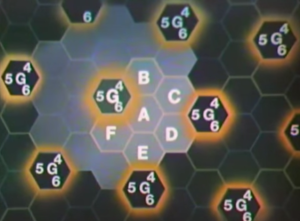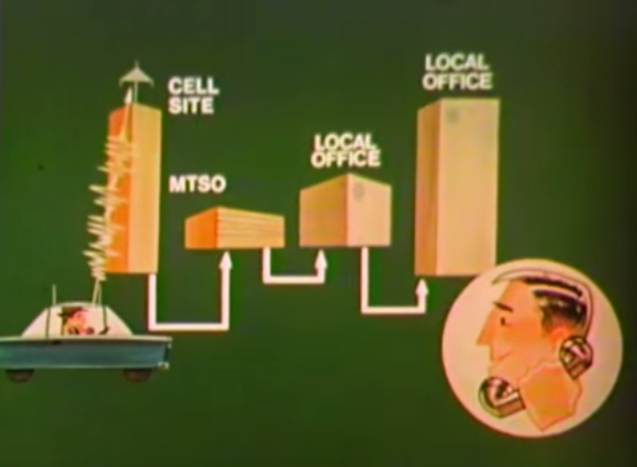This gem from the AT&T Archive does a good job of explaining the first-generation cellular technology that AT&T called Advanced Mobile Phone Service (AMPS). The hexagon-cellular network design was first conceived at Bell Labs in 1947. After a couple of decades spent pestering the FCC, AT&T was awarded the 850MHz band in the late 1970s. It was this decision coupled with the decades worth of Bell System technical improvements that gave cellular technology the bandwidth and power to really come into its own.
AT&T’s primary goals for the AMPS network were threefold: to provide more service to more people, to improve service quality, and to lower the cost to subscribers. Early mobile network design gave us the Mobile Service Area, or MSA. Each high-elevation transmitter could serve a 20-mile radius of subscribers, a range which constituted one MSA. In the mid-1940s, only 21 channels could be used in the 35MHz and 150MHz band allocations. The 450MHz band was introduced in 1952, provided another 12 channels.
 The FCC’s allocation opened a whopping 666 channels in the neighborhood of 850MHz. Bell Labs’ hexagonal innovation sub-divided the MSAs into cells, each with a radius of up to ten miles.
The FCC’s allocation opened a whopping 666 channels in the neighborhood of 850MHz. Bell Labs’ hexagonal innovation sub-divided the MSAs into cells, each with a radius of up to ten miles.
The film explains quite well that in this arrangement, each cell set of seven can utilize all 666 channels. Cells adjacent to each other in the set must use different channels, but any cell at least 100 miles away can use the same channels. Furthermore, cells can be subdivided or split. Duplicate frequencies are dealt with through the FM capture effect in which the weaker signal is suppressed.
Those Bell System technical improvements facilitated the electronic switching that takes place between the Mobile Telephone Switching Office (MTSO) and the POTS landline network. They also realized the automatic control features required of the AMPS project, such as vehicle location and automatic channel assignment. The film concludes its lecture with step-by-step explanations of inbound and outbound call setup where a mobile device is concerned.
Retrotechtacular is a weekly column featuring hacks, technology, and kitsch from ages of yore. Help keep it fresh by sending in your ideas for future installments.
















I wish they uploaded more content on youtube at that time. We would have more information about understanding of things back then.
Duh, time did not exist before 1989.
Nor did Youtube before Feb 2005
666 eh? Proof that cellphones are the devil’s work! Gotta go put a Bible/Koran/Book of Mormon next to each of my land lines now…
Actually, this is pretty interesting stuff even if the tech is many generations old.
I worked with a Seattle-based cellular company in the early 1980s. Keep in mind that a critical selling point to get the FCC to allocate spectrum was a promise to keep reducing the size of cells, primarily by lowering antennas, as the number of subscribers increased.
That seems to have been forgotten as cell companies have use digital technology to open up more channels in the same spectrum and called for more and more bands. Eventually, they’ll need to get back to that approach, which happens to be particularly good at filling in holes in coverage. Rather than have a tall tower attempting to cover everyone for miles around and missing those in valleys, place the tower at the bottom of the valley, reach everyone in it, and re-use those frequencies just a few miles away.
Modern cellphone systems make extensive use of small cells to increase frequency reuse. The large towers provide “umbrella cells” to fill in areas not covered by smaller cells.
Look carefully, and you will see the low antennas for the smaller cells mounted on power poles, water towers, buildings, church steeples, parking decks, etc.
I remember when surplus AMPS parts could be bought dirt cheap. Weren’t any good for their original use when AMPS was replaced, but I assume hobbyists scavenged tons of components from them.
I’ve got a few 3W AMPS units I’ve got set aside waiting for me to have the time to reverse engineer the control portion to convert them to the ham band…
There was a huge dump of cell-site transmitters, when they went from analog to digital modes. I remember seeing them on eBay. I have in my bookcase, here at work, some “SGTF1019R” 900 MHz power amplifier modules — bought off eBay for a project, but never used. 100 watts, I think — two strips and a power combiner inside a hulking aluminum heatsinked plug-in housing. Must wigh a good 20 pounds each.
Yup – here’s a guy who built a 902 MHz ham radio from one of the two strips in my amplifier modules:
http://k5tra.net/902.html
Realy interesting to see how early the concept was. I bought my first “cel phone” in 1986, a Nokia VT1 (Mobira Talkman)/ I had always wanted to re-enact a scene from “The Wheeler Dealers” 1963, James Garner & Lee Remick.
http://youtu.be/KbyehYSoGas
This has a scene where Garner & Remick are driving in a convertible, and Garner is talking on redio phone. A bell rings and Remick picks up another handset, after the usual salutations she says “I’m sorry he’s on the other line”. Somewhre around 1988 during a period when I was pretending to be a film directer I was on my way to a shoot, driving up the M1 near Birmingham in England in a rented Renault Espace. I was sitting in the back talking to the client on my mobile, when the second mobile that I had hired with the car rang. It was my mother! The camera assistant who had answered was able to say “Sorry he is on the other line”. Been dining off that ever since.
Mobile phones may be the most significant technology since the wheel, in terms of how society works. Being able to reach pretty much anyone on the planet with the press of a few keys is amazing to someone who was born in 1950. In fact you can reach the ISS by mobile phone.
I love these Retrotaculars. Keep them coming!
Please can we have an edit button so I can correct my spelling and punctuation? Please? Please? Please?
We can put a man on the moon, but we can’t have edit buttons!
I think the current unspoken logic is that edit buttons are too good an opportunity for trolls…
We can put a man on the moon, but we can’t tolerate dissenting opinion. (there’s a extremely distasteful challenger joke in there somewhere… something about arrogance even when the stakes are high… idk)
The correct, “man on the moon” joke is, “We can put a man on the moon, but we can’t put a man in low earth orbit”.
An edit button is item #8billion on the list of things we want to do. We’re at about number 4.